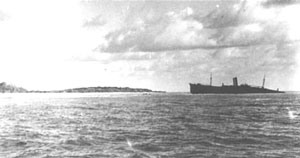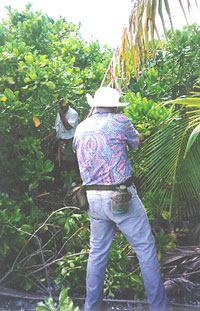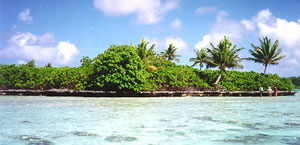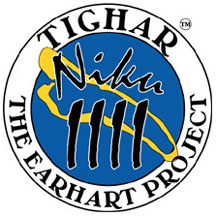|
TIGHAR’s
fifth expedition to Nikumaroro, known as “Niku IIIIP,” was conducted July
1 – 27, 1999 and ran concurrently with an on-site investigation in Fiji,
known as the “Fiji Bone Search,” which attempted to locate the bones and
artifacts known to have been sent there from Nikumaroro in 1941.
|
This is Part One of a four part report on what we’ve accomplished with
this summer’s field work.
- Part One (this
Bulletin) describes the Niku IIIIP expedition, its objectives, costs,
team, and offer a day by day summary of operations.
- Part
Two describes the Fiji Bone Search and reports on the findings of
that team.
- Part
Three, to be put up on September 6, will describe the interviews
conducted in Fiji after the expedition’s return from Nikumaroro and
discuss the significance of the new information obtained.
- Part
Four will present a revised hypothesis and suggest avenues of investigation
which may move the project closer to establishing conclusive proof of
what happened to the Earhart/Noonan flight.
|
|
OBJECTIVES
|
|
The expedition’s
first mission was to determine whether the anecdotal accounts gathered
in Funafuti at the end of Niku III in 1997 might lead directly to discovery
of the main body of wreckage and, thus, permit the Niku IIII expedition
to be organized as an archaeological recovery operation. Recognizing that
the identification of conclusive Earhart wreckage would, by definition,
put those artifacts at risk, this purpose of the expedition was not widely
publicized. No such wreckage was found on this trip, so the point is now
moot. The secondary mission of the expedition was as a preparatory operation
to gather information for Niku IIII, an intensive search operation scheduled
for 2000. The specific objectives of the expedition were:
- Test the hypothesis that airplane parts could be found in the dense
beachfront vegetation of Nutiran district near a “European-style house,”
per an anecdotal account by Tapania Taiki who was interviewed by TIGHAR
on Funafuti in 1997. Ms. Taiki lived on Nikumaroro as a young teenager
with her family in the late 1950s/early 1960s just before the settlement
was abandoned.
- Conduct a reconnaissance of the beachfront areas on the lagoon shore
where Pulekai Songivalu, interviewed by TIGHAR on Funafuti in 1997,
said he saw airplane wreckage when he served as the island’s schoolmaster
during the late 1950s/early 1960s. Mr. Songivalu is Ms. Taiki’s father.
- Conduct a reconnaissance of Kanawa Point, one of three geographical
locations identified by TIGHAR researchers as possibly fitting the description
of where a castaway’s remains and campsite were discovered by Gerald
B. Gallagher, Officer-in-Charge, Phoenix Islands Settlement Scheme,
in September 1940.
- Familiarize the project’s forensic anthropologist, Dr. Karen Ramey
Burns, with the site where shoe parts were found during Niku II in 1991
(known as the “Aukeraime Site”) and conduct a further investigation
of the site with the aid of remote-sensing data gathered during Niku
III in 1997. The Aukeraime Site is the second candidate for where the
bones were found in 1940.
- Familiarize Dr. Burns with the site near the southeast end of the
island where village-related artifacts were found during Niku IIIP in
1996. This is the third location suspected of being where Gallagher’s
discovery took place.
|
|
TEAM
|
|
The team assembled
to conduct these operations consisted of:
| Richard
Gillespie |
TIGHAR
Executive Director |
Project
director |
| Karen
Ramey Burns, Ph.D. |
TIGHAR
#2071E |
Forensic
anthropologist |
| Richard
Reynolds |
TIGHAR
#0981CEB |
Member
of TIGHAR’s Board of Directors, veteran of the Kanton Mission, and
project sponsor |
| Richard
“Skeet” Gifford |
TIGHAR
#0001CEB |
Member of TIGHAR’s Board of Directors and project sponsor |
| Chris
Kennedy |
TIGHAR
#2068E |
TIGHAR
member and project sponsor |
| Ronald
Rich |
TIGHAR
#2267E |
TIGHAR
member and project sponsor |
| Jerry
Ann Jurenka |
TIGHAR
#0772E |
TIGHAR member and project sponsor |
| John
Clauss |
TIGHAR
#0142CE |
Veteran
of Niku I, II, IIIP, III, and the Kanton Mission. |
| Veryl
Fenlason |
TIGHAR
#0053CE |
Veteran
of Niku I, II, IIIP, and III |
| Russ
Matthews |
TIGHAR
#0509CE |
Veteran
of Niku I, II, IIIP, and the Kanton Mission |
| Gary
Quigg |
TIGHAR
#1025CE |
Veteran
of Niku III |
| Van
Hunn |
TIGHAR
#1459CE |
Veteran
of Niku III |
Accompanying the
expedition as an official representative of the Republic of Kiribati was
Senior Examining Officer, Kiribati Customs, Manikaa Teuatabo. Mr. Teuatabo
also accompanied the Niku II and Niku IIIP expeditions.

Standing,
from left: Kar Burns, Russ Matthews, Ron Rich, Skeet Gifford, Jerry Jurenka,
Veryl Fenlason
Kneeling: Gary Quigg, Ric Gillespie, Chris Kennedy, John Clauss, Van Hunn
Not pictured: Dick Reynolds, Manikaa Teuatabo
TIGHAR photo © 1999 |
|
COST
|
|
The direct cost to TIGHAR for the Niku IIIIP expedition was:
| Airfare* |
$5,785 |
| Ship Charter |
$99,492 |
| Kiribati repesentative |
$1,904 |
| Equipment and
incidentals |
$2,500 |
| Total |
$109,681 |
*several
team members paid their own airfare
The cost of the Fiji
Bone Search was:
| Airfare* |
$1,982 |
| Accommodations |
$1,300 |
| Meals and
incidentals |
$2,849 |
| Car rental |
$1,351 |
| Total |
$7,482 |
*one team member
paid her own airfare
In addition to these
direct expenses, TIGHAR’s operating expenses during the period of preparation
and execution of the expeditions (February through July, 1999) were roughly
$90,000.
Grand
Total – $207,523
|
|
OPERATIONS
|
| July 1-3 |
Team flies to Fiji and boards expedition vessel Nai’a at
port of Lautoka. One large bag of expedition gear (with essentials such
as metal detectors and laptop computer) is missing and it takes two days
to track it down and get it to Fiji. When the bag finally arrives the
screen of the laptop has been cracked in transit, but the computer is
still usable. |
| July 5 |
Nai’a
departs Fiji. Once clear of Fijian waters, seas become quite high (approximately
seven meters) with head winds and conficting currents slowing progress
at times to a little as 6 knots. Structural problems with the mast prevent
the use of the sail with consequent loss of its stabilizing and fuel saving
effect. |
| July 6-10 |
Continued
high seas make for an unpleasant passage. No one can go out on the exposed
decks, the galley is limited in what foods can be prepared and served,
spills and breakage are commonplace, and just moving about requires constant
vigilance. Most of the team is seasick to at least some degree and a few
are truly miserable. |
| July 11 |
Having
arrived at Nikumaroro just before dark the previous evening, the team
goes ashore at 07:45 and spends the day surveying and building a trail
from the landing to the shore of the lagoon passage where a skiff, walked
in over the reef at high tide, will be based to ferry the team over to
Nutiran. Seas in the lee of the island are relatively calm – a welcome
relief. However, tropical downpours during the day make the heavy work
of clearing the trail through the jungle a soggy endeavor. It is also
discovered that the ship’s water maker, which had been unusable during
the voyage out due to the extreme rolling, is not working. Without the
ability to make fresh water the expedition must depend entirely upon the
tanks of water aboard the ship. This supply should be adequate if carefully
conserved, but luxuries such as laundry are out of the question. |
| July 12 |
In the
morning a base camp is established on the Nutiran shore and base lines
are “shot in” with the pulse laser from known features on the village
shore to permit accurate mapping of the search area. More heavy rain slows
the work. In the afternoon, the team begins the process of setting out
grid lines 20 meters square in the sector where aerial photography indicates
there was once a structure which may be the “European style house.” Nearby,
the 1953 photo also shows a cruciform feature in the beachfront vegetation
which looks alarmingly similar to an aircraft. Hopes are high for a significant
discovery but the day’s searching yields no sign of a European style house
(a structure built of wood frame and boards rather than local materials),
let alone an airplane. A grave about four feet in length is found not
far from the beachfront. Like the grave excavated on Aukeraime in 1991
and found to be that of an infant, this burial seems to be anomalous in
the context of the island settlement and fits folklore about bones said
to have been found and buried on Nutiran by the early settlers. |
| July 13 |
Further
gridding and searching reveal a scattering of cultural material (nails,
wire, cans, etc.) indicating that a structure of some kind once stood
on the spot where the putative European style house is seen in the 1953
aerial photo, but the absence of boards or framing suggests that the structure
was made from local materials. An area around the grave is cleared and,
after consultation with Dr. Burns, the decision is made to seek permission
from the Kiribati representative to excavate the grave. |
| July 14 |
After
a discussion at the grave site with Senior Examining Officer Manikaa Teuatabo,
permission to excavate is granted and digging begins. Meanwhile, a detailed
search of the area where the cruciform object appears in the photo finds
only vegetation and what may be a broken oarlock – possibly from one of
the lifeboats from the SS Norwich City. Two divers, Van Hunn and
Jerry Jurenka, inspect the lagoon passage and inshore reef area at high
tide for any anomalous material. The results are negative. Search operations
are extended northward along the Nutiran shore in the hope of finding
something that better fits the description of a European style house.
Late in the day,
Chris Kennedy comes upon boards and sheets of corrugated metal. Further
investigation reveals the ruins of a structure incorporating wood framing
and boards. There are pipes, a faucet, and even a shower head. It seems
quite likely that this was a European style house but it does not seem
to be present in the 1953 aerial photos. Plantings of coconut and pandanus
just inland from this location support the possibility that this structure
is a relic of development in the later days of the settlement. That would
conform to Ms. Taiki’s time on the island in the late 1950s. Among the
debris where the house once stood is a small (1.5 inch by 5 inch) piece
of aluminum aircraft skin which had been cut through rivet holes along
one long edge. The presence of zinc chromate corrosion inhibitor would
appear to disqualify it as being from Earhart’s aircraft. |
| July 15 |
On doctor’s
orders, one team member with a foot infection remains aboard ship and
is on antibiotics. Ashore, while Dr. Burns and two assistants, Quigg and
Gifford, proceed with the grave excavation, the rest of the team begins
to lay out grids and search the area southward from the newly-identified
European house. Heavy iron debris from the shipwreck is found as much
as ten meters back into the beachfront vegetation along the shoreline
directly in front of and southward from the Norwich
City, but no aluminum
or aircraft-related material is in evidence. Because it will be roughly
the half-way point in the expedition, the following day is declared a
“day off” for anyone who needs to take a break. Aboard ship, the water
maker is still not working. |
| July 16 |
On this
“day off” the entire team turns out for duty except for two people with
minor injuries. Further gridding and searching southward from the European
house fail to turn up anything of interest. Dr. Burns’ team reaches
the interment in the grave and finds the bones of a two or three year
old child. As previously agreed, as soon as the grave is established
to be unrelated to the Earhart mystery, further excavation ceases and
the grave is later restored to its original condition and appearance.
 |
The
S. S. Norwich City in 1937.
Photo courtesy Eric Bevington.
Used by permission. |
At 13:00 a satellite
telephone communication with TIGHAR’s office in Delaware brings the news
that Dr. Tom King in Fiji has interviewed a former resident of Nikumaroro
who reports having seen aircraft wreckage (heavy structures, not aluminum
sheet) on the reef north of the Norwich City shipwreck in the years
prior to WWII (1939-1941). Reports dating from the late 1950s had placed
scattered aircraft wreckage on the reef and along the shoreline south
of the shipwreck. This new information matchs our previously-formulated
hypothesis that the landing had been made on the reef and the airplane
destroyed by surf action, but indicates a more northerly specific location
than we had previously contemplated.
Later in the afternoon
Gillespie and Clauss conduct a reconnaissance of the lagoon shore in the
area where Mr. Songivalu reported seeing airplane wreckage. While access
to the area by skiff is not as difficult as had been anticipated, the
beachfront vegetation is quite heavy in most areas until a low ridge of
land about 50 meters inland from the lagoon shore marks the beginning
of open Buka (Pisonia grandis) forest. A variety of lightweight
flotsam (plastic, styrofoam, etc.) indicates that this first 50 meters
of shoreline is occasionally subject to flooding, but conducting a thorough
search of the entire shoreline by visual means would be labor intensive
and time consuming.
|
| July 17 |
 | Veryl Fenlason
and John Clauss shoot in a line in dense scaevola. Photo courtesy Richard
Gifford. |
Temperatures
hover near 100 degrees Fahrenheit as they have since the team’s arrival
on the island. Shifting the Nutiran shoreline search northward based on
the new information, the team begins inspecting the dense beachfront scaevola
from the point of land just off the bow of the Norwich City wreck
and working northward. In an attempt to inspect open areas inland, Gillespie
leads several team members into vegetation so thick that it takes hours
to cut their way out and resume an organized search. The methodology developed
for searching what can only be described as the beachfront scaevola wall
is for transects to be cut into the bush on a heading 90 degrees to the
shoreline and flagged with colored tape. The flagged transects are spaced
25 meters apart and go back into the scaevola far enough to be well beyond
any evidence of washed up material (typically 30 or 40 meters). Searchers
then space themselves along the beach closely enough to be sure they can
visually cover the area between themselves and their colleagues on either
side — and start cutting their way in, staying on line as much as possible,
much like the beaters in an old-fashioned tiger hunt. When the line reaches
the end of the flagged transects the searchers make their way back to
beach, move down to the next block, and start all over again.
Yet another grave is identified on the point just off the bow of Norwich
City but excavation is not an option due to lack of remaining time. In
the afternoon, at low tide, an inspection of the reef north of Norwich
City permits a preliminary evaluation of areas that appear flat and smooth
enough to permit a Lockheed 10 to land intact.
That evening aboard Nai’a the water maker is still not working despite
heroic attempts at repair by the ship’s crew. Team members accomplish some
semblance of laundry by showering fully clothed. Quasi-clean clothes are then
dried overnight in the ship’s drier. |
| July 18 |
In the morning, while most of the team continues to work
northward along the Nutiran shore, cutting 40 meter transects back into
the bush at five to ten meter intervals, Gillespie, Matthews, Clauss
and Burns conduct a reconnaissance of Kanawa Point. The cove just east
of the Point is found to be very deep in soft silt, making the landing
of a skiff difficult (and dangerous if you don’t realize that what looks like a sandy bottom is,
in effect, quicksand. Hop out of the boat to push it ashore and – gloop –
you’re gone). Kanawa Point, while probably orignally quite open
and pleasant when shaded by Kanawa trees, is now so covered in dense
scaevola as to be impossible to search visually from any practical standpoint.
On the lagoon shore across the cove to the east of Kanawa Point, a feature
first noted by Tom King in 1989 was noted. The coral shelf above the
water line is strewn with the shells of an estimated 300 giant clams
over an area easily 20 meters long by perhaps 5 meters wide. In some
cases the shells have been there so long as to be cemented into the coral
and, in at least one spot, a number of shells are neatly stacked, back
to front. There is no doubt that this is where a human or humans harvested,
opened, and possibly ate clams. A few clams still grow in the surrounding
shallow water. A scattering of shells was also found on the shore of
Kanawa Point itself.
 |
Kanawa
Point. Photo courtesy John Clauss. Used by permission. |
The Aukeraime Site
was also visited briefly. There has been a significant increase in lagoon
shore scaevola growth since TIGHAR’s last visit in 1997. A metal detector
inspection of a spot where remote-sensing data gathered in 1997 suggested
there might be metal in the ground was negative. With time short, a decision
was made to forego a visit to the southeast corner of the island.
In the afternoon,
at low tide, further inspections and measurements were taken on the reef
flat north of Norwich City and the pulse laser was employed to
measure the length of areas that were smooth enough to permit a safe landing.
The longest area measured was 213 meters (700 feet). It has been estimated
that Earhart’s aircraft, at near empty weight and landing into a 10 to
15 knot wind as is common on the reef flat, could come to a stop in as
little as 91 meters (300 feet).
 |
The S.S. Norwich City, with Nai’a in the background.
Photo courtesy
Veryl Fenlason. |
With one more full day of work remaining before the ship must depart for
Fiji, the water maker is finally working. |
| July 19 |
Inspection
of the heavy beachfront vegetation north of Norwich City continues.
In addition to the search conducted at the southern tip of Nutiran in
the area around the initially-supposed “European style house” and
the gridding and searching done near the ruin that does seem to fit that
description, the entire length of the Nutiran beachfront from the north
point southward to the west point just below the shipwreck, a distance of
some 700 meters (nearly half a mile) has been searched visually to a depth
into the vegetation of 30 to 40 meters. The search turns up no aircraft-related
debris. Norwich
City debris is present on the reef and in the first few meters of
beachfront vegetation from a point perhaps 50 meters north of the bow
to at least 500 meters southwestward down the beach. The reef and shoreline
north of the wreck are free of any type of cultural debris other than
flotsam (buoyant objects) and these occur primarily on the open beach
and in the first 20 meters of vegetation. After nine solid days of heavy
physical labor in the intense heat, many team members are becoming dangerously
exhausted. |
| July 20 |
Departure
day. The skiff must be brought out of the lagoon by noon at high tide
and the morning is spent finishing up some last minute searching, breaking
camp and recovering all of the equipment back across the lagoon passage.
By 14:00, everything and everyone is off the island and that evening Nai’a
sets a course for Fiji. |
| July 21-25 |
As
if to make up for the rough outward passage, the trip back to Fiji is
smooth and fast, arriving in the port of Suva a full day ahead of schedule.
This permits us to terminate the charter a day early and thus save nearly
$5,000. |
Part
Two of this report will detail the interviews conducted in Fiji after
the expeditions return from Nikumaroro and before its departure for the
United States.
|


